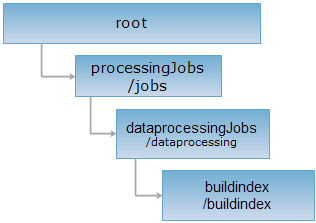
<dataprocessingJobs_uri>/buildindex[.<format>]
buildindex resource represents the root resource of creating spatial index. And it lists all the available creating spatial index job resources.
Supported Methods:
Supported output formats: RJSON, JSON, HTML, XML.

Execute HTTP request on the following URI, here we take rjosn as the output format as an example. Where, supermapiserver is the server name.
http://supermapiserver:8090/iserver/services/distributedanalyst/rest/v1/jobs/dataprocessing/buildindex.rjson
Gets the entry of creating spatial index job.
After executing a GET request on buildindex resource, the response entity is a set of data processing resource descriptions, and the response fields of single resource are as follows:
| Field | Type | Description |
| name | String | Spatial analysis job name. |
| path | String | The access path of the resource. |
| resourceConfigID | String | The ID of the resource configuration item. |
| resourceType | String | Resource type. |
| supportedMediaTypes | String[] | The media type of the supported representations. |
By executing a GET request on buildindex resource, the returned response result in rjosn format is as follows:
[{
"resourceConfigID": null,
"supportedMediaTypes": null,
"path": "http://supermapiserver:8090/iserver/services/distributedanalyst/rest/v1/jobs/dataprocessing/buildindex/grid",
"name": "Grid",
"resourceType": null
}]
Returns the same HTTP response header as the GET request, but no response entity, which can be used to retrieve the meta data contained in response message header without having to transmit the entire response content. Meta data information includes media type, character coding, compression coding, entity content length, etc.
HEAD request is used to determine whether the buildindex resource exists, or if the user has the authority to access it. By executing an HEAD request with a .<format> URI, you can quickly determine whether the buildindex resource supports the <format> representation.